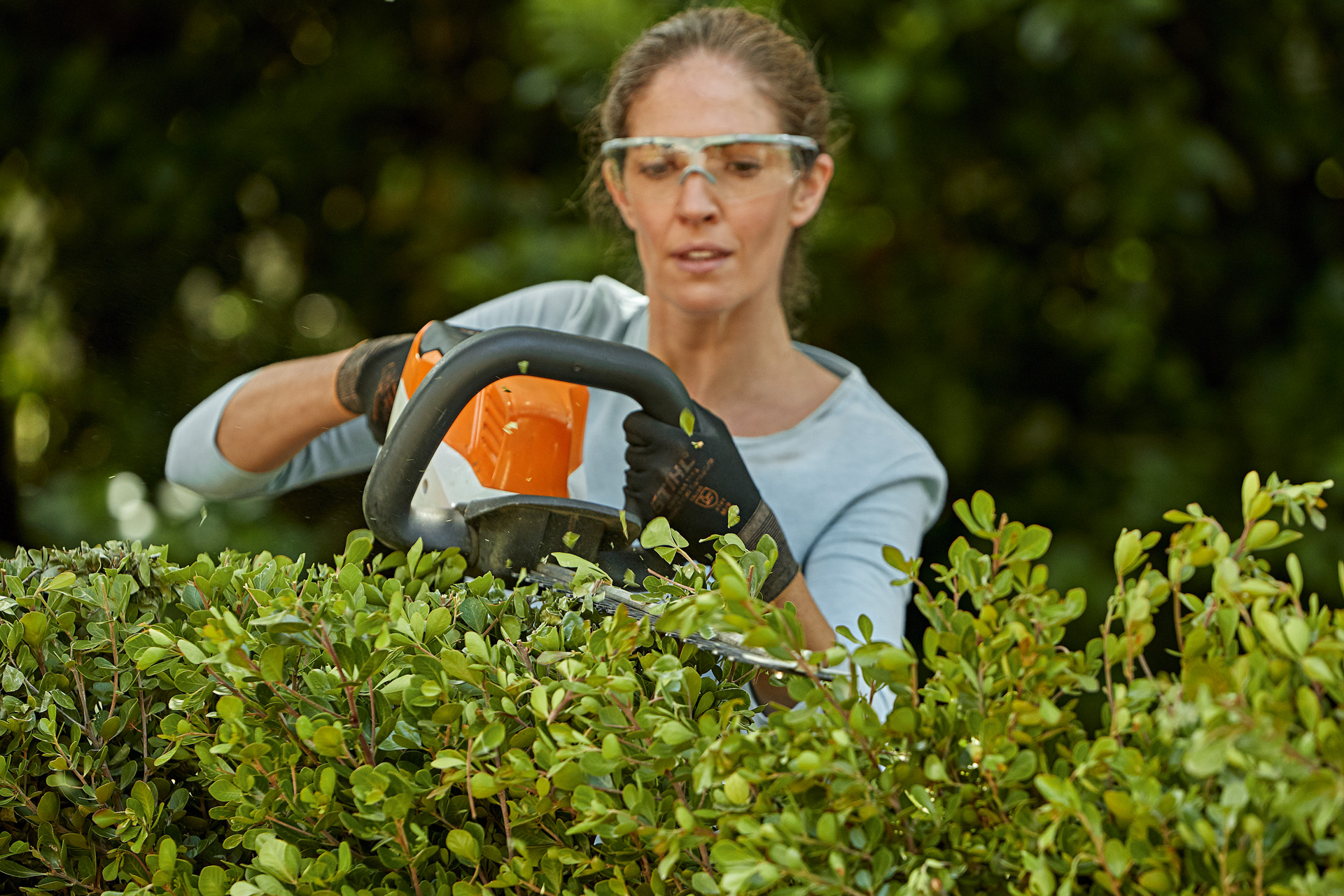LAWN CARE IN SUMMER: HOW TO TAKE CARE OF YOUR LAWN
Whether the summer brings a heatwave or a downpour, your lawn has a lot to battle with. We show you the most effective ways to protect it. In the following article we will show you how to take care of the lawn, how often to mow lawn in summer and other useful summer lawn care tips for the hot season.
26.03.2025

How to water your lawn when temperatures are high
Watering your lawn is one of the most important maintenance measures to consider all year round, and particularly in summer when there is often little natural rainfall. As a rule of thumb for lawn care, you need to supply approximately 20 to 25 l of water per square meter per week – depending on sunlight, heat levels and wind.
How much water does my lawn need?
If you’re an amateur gardener, you’ll need to use more than you probably expect. In general, lawn maintenance in summer means supplying each square meter of your lawn with 20 to 25 l. However, it’s important to remember that overwatering your lawn can also be harmful, as it displaces air from the pores in the soil – which can cause root rot. Take a sample from your soil and have a sniff of it: if it smells bad or is gray-blue in color, it’s highly likely to be waterlogged, suffocated and in need of care.

Tips for watering your lawn in summer
- Once a week is enough for watering in your summer lawn care schedule, using approximately 20 l of water per square meter each time. This amount should be varied to account for the specific site and weather conditions.
- Clay soil: clay-rich soils are prone to baking hard in summer, so may need a little additional care. If your soil cannot absorb the full volume given in one go, water more lightly but twice in quick succession (or on the next day), and then don’t do it again for a week.
- Make sure you are watering evenly. When taking care of your lawn, the last thing you want is for summer heat to cause dry patches – you can use a soil moisture meter to check that the lawn is sufficiently hydrated all over.
- Do your watering in the early morning or late evening, as strong, direct summer sun can scorch a damp lawn.
- If you have trees, shrubs or hedges growing around your lawn, increase the amount of water you give it.
- In the extreme heat that can occur in midsummer, your lawn needs extra care: increase your watering frequency to two to three times a week, in the early morning or in the evening.
Summer lawn care: Checking the moisture of your lawn
In a dry summer it's important to know that your lawn is getting enough to drink. If you don’t have a moisture meter, you can check by placing a number of jam jars in various locations in your yard: there should be around 2 cm of water in all the jars after rain or watering, if the grass has received enough. From this, after some trial and error you will be able to gauge water needs perfectly so your lawn need never be stressed by the summer heat, and you can give it the right care just when it needs it.
Another method is to insert a strong blade or spade into the ground to extract a sample of soil to a depth of around 10 cm, in several places; in a well-watered lawn, in summer the deeper soil should be damp (not wet) and the top 1 to 2 cm should feel dry – it should never be the other way around. If the sample is damp on top and dry underneath, the water is not getting to where it’s needed.
Common mistakes in summer lawn maintenance
When it comes to watering in summer, the most common mistake is doing it both too frequently and insufficiently deeply each time. Many people have a schedule for lawn care that involves giving their lawn a light watering every evening during the heat of summer – but this causes longer-term problems. That’s because it is mainly lawn thatch that gets dampened if you do this, along with just the top few millimeters of soil in the best-case scenario; over time the grass responds by concentrating its roots close to the surface of the soil, making it particularly vulnerable to summer stress. Another effect is that lawn thatch will quickly build up and start to dominate, because it prevents any moisture from reaching the soil underneath – so the lawn keeps drying out. The lawn is now unhealthily “addicted” to moisture, and after just a few summer days of not watering, it will quickly turn yellow and need extensive care, as well as being much more susceptible to fungal diseases.

CUTTING GRaSS IN HOT WEATHER: When to mow your lawn in summer
Your grass is at the top of its game in early summer as it comes out of spring, and so it will be bursting with strength and growth. That means your summer lawn care schedule can certainly include mowing every four to seven days when summer begins. In fact, such regular mowing encourages your lawn to grow more densely, by stimulating the grass to develop new side shoots – even though keeping the grass at the right height is actually more important than the frequency of mowing.
How often should grass be cut in summer?
The higher the temperatures, the longer the grass should stay to protect the sensitive blades: Mow the lawn at 4 to 5 centimeters in sunny areas, 5 to 7 centimeters in shady areas. If a heat wave is foreseeable, the lawn can also be left in the sun a little longer so that the blades shade each other. As a general rule, no more than a third of the length should be shortened per mowing operation to avoid unsightly burns and blemishes in the lawn. Always use sharp mower blades and ensure that the ground is dry.

STIHL multi-mowers offer superb cutting precision
If you’ve neglected the lawn care for a while by the time summer arrives, you may need to mow the grass in multiple passes, initially using the highest possible cutting setting and then a lower one. All STIHL multi-mowers feature a convenient cutting height adjustment option so that you can set the right cutting height for your lawn.

What can I do about indentations on the lawn?
Particularly in summer, if blades of grass do not automatically stand up again after being walked on this can indicate dehydration. Take a look at your watering routine, and consider a weekly schedule using 20 to 25 l for each square meter.
How to feed your lawn in summer
By the start of summer, the nutrients from the spring fertilizer application have almost been used up. To best care for your lawn through the season of boisterous football matches and barbecues, we recommend you fertilize again at the start of summer. In fact, even lawns that don’t see this sort of traffic can benefit from a vitamin boost right now, as frequent early-season mowing means many of the nutrients in the grass will be lost in the cuttings, which puts a lot of strain on the soil in the long term. That’s why it is so important to return vital nutrients to the lawn in summer, and the best way to do it is by applying a mineral lawn fertilizer.
The right summer fertilizer
When choosing the right fertilizer for your summer lawn treatment, it needs to contain these essential ingredients for keeping your soil and lawn healthy:
| Active ingredient | Description |
|---|---|
| Potassium (K) | Increases pest resistance, regulates plants’ metabolism |
| Phosphorus (P) | Strengthens root growth and helps to protect against frost |
| Magnesium (Mg) | Supports chlorophyll formation during photosynthesis and ensures that the lawn is a vibrant green colour |
| Calcium (Ca) | Stabilises the cell walls of the grass and helps the plants to absorb nutrients from the soil |
| Nitrogen (N) | Encourages cell division and therefore the regeneration of all parts of the plant. Stimulates lawn growth |
It’s important for these minerals and nutrients to be present in the appropriate concentration; alongside plenty of nitrogen for growth, magnesium and calcium are required at higher levels to ensure that your lawn can withstand both extreme heat and summer storms.
Lawn care tips for feeding your lawn in summer
- Get the feeding in early. You should ideally fertilize your lawn in June to prepare it for the hot summer ahead.
- Promote dense growth by using slow-release fertilizers; with these, the grass grows slowly through the summer but becomes thicker and more resilient.
- Use a sprinkler system – this makes it easy to water the lawn generously but carefully after fertilizing.
Summary: Lawn care in summer
- Water liberally once a week, at a rate of at least 20 l per square meter
- Flattened patches of lawn may indicate insufficient hydration
- Take care to regularly check your lawn’s moisture levels and adjust watering requirements accordingly
- Mow your lawn at least once a week in summer, reducing the length of the grass by a third each time. Sunny lawns should be between 4 and 5 centimeters high. During strong heat waves, the lawn can also be slightly longer.
- Shady lawns should have a minimum height of 5 cm.
- Fertilize your lawn in June to prepare it for peak summer heat
/catalogue/stihl-catalogue-2016-(dv)/glossary/page-258/686716a4d60d4d578e192da779f2caa6.jpg)

